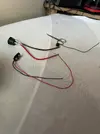This is a document I've put together a long time ago but never got to finish and post. It aims at being an all-in-one reference for the Flux Capacitor. Designs, improvements, feedback/testimonials, and more. We're attempting to come up with the best, most reliable parts and schematics as possible.
What is the Bajak Flux Capacitor?
The John Bajak Flux Capacitor often called Flux Cap or fluxcap, is a small time travel device. It is often mentioned alongside the HDR, Sonic Resonator and other small devices. It's a design that showed up on the old KeelyNet BBS in the 1990s. It's available on a very old website, called Amasci, which is linked at the end of this post. The Flux Cap schematics are available over there, as well as a few old forum posts from the late 90s and early 2000s that share some information about it. We have an on-site copy of the original Bajak file, as a backup for future reference.
In the document, the creator explains how he came to build it by accident, and how it could potentially be used for time travel. He even mentions the possibility of attaching it to a car, in order to create a time travel vehicle. It gets pretty technical towards the end, you'll see.
Here are 2 links to the original document:
John Bajak FluxCap Document (Paranormalis):
John Bajak Flux Capacitor Time Travel Circuit
John Bajak FluxCap Original Document Location (Amasci):
http://www.amasci.com/freenrg/bajak1.txt
The FluxCap is supposed to emit some sort of small temporal field (temporal flux) that would alter the rate at which time flows. It would, for instance, slow down or accelerate a watch by having it oscillate between past and future.
Quote from John Bajak:
View attachment 12555
Parts List and schematics
B1 27 volt source
C1 1200 uF 50V electrolytic
P1 Piezoelectric transducer (273-073) (value uncritical)
S1 Charging switch (SPST)
G1 25-ohm rheostat (future control)
G2 1M-ohm potentiometer for past control
G3 Switch (SPST)
Transcriber's note: I don't know whether G1 and G2 are really supposed to be a rheostat and a potentiometer, or both rheostats, or both pots. He refers to two rheostats elsewhere, and I was just going to call them pots until I remembered that rheostats would have some inductance.
View attachment 12556
How to build the Flux Cap
We don't have building instructions at this point. Suggestions welcome.
Does anyone have schematics others than the one above? Actual schematics that are not in ASCII would be greatly appreciated.
How to operate the Flux Cap
The information we have as to how to operate the Flux Cap is as follows:
We encourage anyone who knows more about the Flux Cap to get in touch and share what they know. For instance, what do the above instructions do? Do they deal with the past? The future? How do you know which way the device is set to?
Links of interest
John Bajak FluxCap Document (Paranormalis):
John Bajak Flux Capacitor Time Travel Circuit
John Bajak FluxCap Original Document Location (Amasci):
http://www.amasci.com/freenrg/bajak1.txt
Report of Unusual Phenomena page, containing info about the Flux Capacitor:
Report your Unusual Phenomena: experiment reports
Bajak Report File:
John Bajak's Flux Capacitor Report File
Modified Versions of The Flux Capacitor:
Schematics - Modified Versions of The Flux Capacitor
Discussion about the Flux Capacitor:
Discussion About The John Bajak Flux Capacitor
Bajak Wolf Flux Capacitor:
Bajak Wolf Flux capacitor


